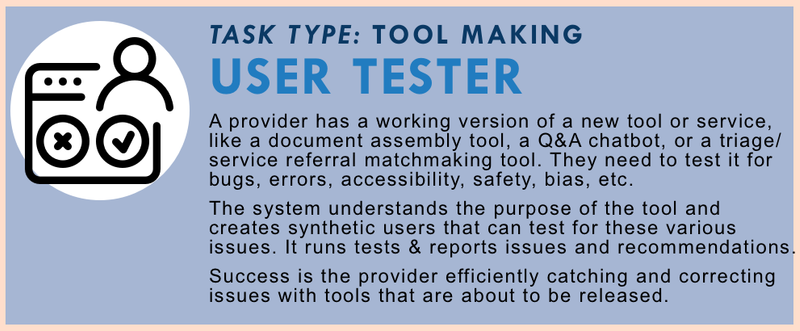User Tester

Help providers automatically test new legal help tools & projects for bugs, safety risks, accessibility issues, and fairness—before public release.
Task Description
When legal teams build new tools—like guided interviews, chatbots, or referral matchers—those tools must be rigorously tested before going live. A single error or inaccessible path could confuse users, misstate the law, or reinforce bias. Yet most legal tech teams don’t have the resources for robust QA, especially across diverse user types and scenarios.
This task envisions a system that acts as a testing co-pilot. It understands the function of the tool being evaluated and generates synthetic user profiles with varied backgrounds, legal issues, and interaction patterns. It then runs automated tests to simulate how real users might navigate the tool—including edge cases, language differences, device limitations, and more.
The system identifies problems such as broken logic branches, inaccessible interface elements, confusing instructions, inaccurate legal outputs, or signs of bias. It then delivers a report outlining issues found, severity levels, and suggestions for fixes or improvements. Providers can use this feedback to refine the tool before public rollout.
For the provider, this AI-powered QA process dramatically increases confidence in the tool’s quality while reducing the time and manual effort usually needed for testing. It brings professional-grade testing capacity—often only seen in commercial software environments—into access to justice work.
Success means providers can rapidly catch and correct usability, accuracy, and equity issues in their tools—before they reach the public—ensuring greater trust, effectiveness, and safety in legal service delivery.
How to Measure Quality?
🐞 Bug and Logic Error Detection
- Detects broken links, validation failures, and skipped logic branches
- Flags unpopulated fields or incorrect default behavior
- Provides clear descriptions and line references for each error
♿ Accessibility Compliance
- Detects missing alt text, ARIA labels, or improper tab orders
- Tests for keyboard-only navigation and screen reader compatibility
- Evaluates readability and color contrast against WCAG standards
⚖️ Bias and Fairness Audits
- Simulates users across race, income, gender, disability, and geography
- Checks for discriminatory outcomes or systemic gaps in access or advice
- Flags imbalances in referral recommendations, eligibility filtering, or tone
🔐 Safety and Legal Risk Detection
- Flags inaccurate legal statements or dangerous oversimplifications
- Tests edge cases (e.g., survivors of violence, undocumented users)
- Checks for missing disclaimers, jurisdiction mismatches, or risky advice
📊 Synthetic User Coverage
- Runs tests across a variety of realistic user scenarios
- Includes high-risk profiles and unusual combinations of circumstances
- Allows provider to define custom test personas
⚙️ Provider Review and Feedback Integration
- Outputs readable QA report with issue summaries and fix suggestions
- Allows staff to re-test fixed items and validate corrections
- Supports tagging or categorizing issues (e.g., critical, accessibility, legal content)